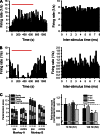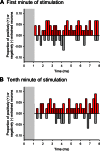Effects of high-frequency stimulation of the internal pallidal segment on neuronal activity in the thalamus in parkinsonian monkeys
- PMID: 27683881
- PMCID: PMC5168000
- DOI: 10.1152/jn.00104.2016
Effects of high-frequency stimulation of the internal pallidal segment on neuronal activity in the thalamus in parkinsonian monkeys
Abstract
Deep brain stimulation of the internal globus pallidus (GPi) is a major treatment for advanced Parkinson's disease. The effects of this intervention on electrical activity patterns in targets of GPi output, specifically in the thalamus, are poorly understood. The experiments described here examined these effects using electrophysiological recordings in two Rhesus monkeys rendered moderately parkinsonian through treatment with 1-methyl-4-phenyl-1,2,3,6-tetrahydropyridine (MPTP), after sampling control data in the same animals. Analysis of spontaneous spiking activity of neurons in the basal ganglia-receiving areas of the ventral thalamus showed that MPTP-induced parkinsonism is associated with a reduction of firing rates of segments of the data that contained neither bursts nor decelerations, and with increased burst firing. Spectral analyses revealed an increase of power in the 3- to 13-Hz band and a reduction in the γ-range in the spiking activity of these neurons. Electrical stimulation of the ventrolateral motor territory of GPi with macroelectrodes, mimicking deep brain stimulation in parkinsonian patients (bipolar electrodes, 0.5 mm intercontact distance, biphasic stimuli, 120 Hz, 100 μs/phase, 200 μA), had antiparkinsonian effects. The stimulation markedly reduced oscillations in thalamic firing in the 13- to 30-Hz range and uncoupled the spiking activity of recorded neurons from simultaneously recorded local field potential (LFP) activity. These results confirm that oscillatory and nonoscillatory characteristics of spontaneous activity in the basal ganglia receiving ventral thalamus are altered in MPTP-induced parkinsonism. Electrical stimulation of GPi did not entrain thalamic activity but changed oscillatory activity in the ventral thalamus and altered the relationship between spikes and simultaneously recorded LFPs.
Keywords: deep brain stimulation; monkey; parkinsonism.
Copyright © 2016 the American Physiological Society.
Figures






References
-
- Aldridge JW, Gilman S. The temporal structure of spike trains in the primate basal ganglia: afferent regulation of bursting demonstrated with precentral cerebral cortical ablation. Brain Res 543: 123–138, 1991. - PubMed
-
- Alexander GM, Fisher TL, Godwin DW. Differential response dynamics of corticothalamic glutamatergic synapses in the lateral geniculate nucleus and thalamic reticular nucleus. Neuroscience 137: 367–372, 2006. - PubMed
-
- Anderson ME, Postupna N, Ruffo M. Effects of high-frequency stimulation in the internal globus pallidus on the activity of thalamic neurons in the awake monkey. J Neurophys 89: 1150–1160, 2003. - PubMed
-
- Angeli A, Akram H, Zacharia A, Limousin P, Hariz M, Zrinzo L, Foltynie T. Varying time-course of effects of high frequency stimulation of sub-regions of the globus pallidus in patients with parkinson's disease. Parkinsonism Relat Disord 21: 597–602, 2015. - PubMed
Publication types
MeSH terms
Substances
Grants and funding
LinkOut - more resources
Full Text Sources
Other Literature Sources

